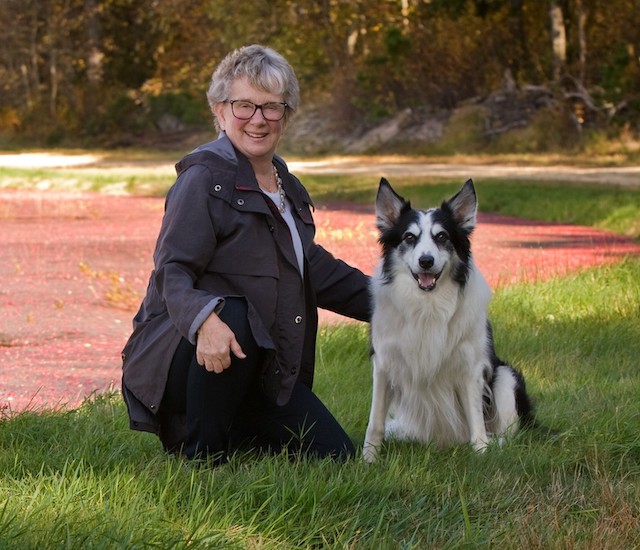
Wendy Williams and friend: ‘Who doesn’t love butterflies?’ (Photo: Rich Maclone)
By Duncan Strauss
If you think butterflies are beautiful and magical, as I do, it turns out we’ve still greatly underestimated them.
That impression hit me like a swarm of Monarchs while reading The Language of Butterflies: How Thieves, Hoarders, Scientists, and Other Obsessives Unlocked the Secrets of the World’s Favorite Insect, the latest book by author Wendy Williams. Butterflies is chockful of unexpected tidbits that–whatever your current level of interest in these flying insects–will likely elevate it considerably while elevating your appreciation for them along the way.

In The Language of Butterflies, this ranges from small, though still intriguing declarations, to more consequential revelations. In the first category, for example, Williams breaks the unlikely news that butterflies don’t like to get up before 10 a.m.
“No, they don’t. And neither do I, so that works well,” Williams said in a June Talking Animals interview.
This is such an oddly specific detail. I wondered how she knows it.
“I was, to a certain degree, being tongue-in-cheek, but not entirely,” she said. “Butterflies tend not to be active until the sun is really up. That’s why you can tie their wake-up time to a specific hour, because wherever you are on Earth, the hour of 10 o’clock is tied to when the sun begins to get strong.
“They really are resting overnight. That’s a general difference between butterflies and moths. Moths fly in the darker hours, and butterflies fly in the lighter hours. Now, that’s not 100 percent true. There are always exceptions. But It’s about 10 o’clock in the morning when the sun gets to be strong enough that the butterflies really start to go out and seek the sun. Remember what I explained in the book is that their energy system is dependent on the sun.
“They don’t have an internal system that creates warmth like we do, a heart that beats warm blood. They have an exoskeleton, and they’re dependent on the energy of the sun to get their whole system going.”

Millions of monarch butterflies flutter to the mountains of Mexico every October
See what I mean? A tidbit that’s tiny and quirky is connected to something broader and more fascinating about butterflies.
That’s the way Williams rolls in this book. And yields yet another detail that even a staunch butterfly enthusiast probably didn’t know. (You lepidopterists amongst us are, of course, exempt.)
If The Language of Butterflies is brimming with gripping disclosures, that’s mostly a direct reflection of the sense of discovery–sense of awe, even–that Williams experienced while researching the book, lighting on one captivating development after another.
“I went down the rabbit hole, I just couldn’t stop reading,” Williams recalled, sounding excited even now. “And then I would find other amazing things. I found people who had studied the structure of butterfly scales, and what they had discovered. I found other people who were [investigating] this great mystery: how do Monarch butterflies fly all the way from sometimes Canada all the way to south of the Mexican border, get to nearly Mexico City, then take a right turn and go up to this one small area in the mountains in Mexico?”
But even that represents only a portion of Monarch’s herculean migration efforts: There are a few outliers each year who make their way from North America to England, while some have traveled to Australia.
Part of what makes the book a striking read isn’t just the accounts of insect derring-do (or late wake-up calls), but also the notable humans that people Williams’ pages. For example, the novelist Vladimir Nabokov turns out to have been a major, revered butterfly expert.
And Charles Darwin makes an appearance, but in part, for not being a butterfly aficionado. “A lot of people collected butterflies in Darwin’s era, but Darwin was unique in that he collected beetles,” Williams said. “He was really interested in beetles, and really didn’t know very much about butterflies.
“But fortunately, for him, there were two fellows younger than him who had left England and gone to South America to collect butterflies. They wrote him some letters in which they explained that not only did butterfly wings evolve, but they had actually seen the evolution happen over the course of generations in front of their very eyes. They provided proof. They said, ‘I know you think evolution happened in the past, but evolution actually is still happening in our modern day,’ which was the 1870s.”

5 Things You Didn’t Know About Butterflies
At the same time, someone far less known than Darwin–an otherwise obscure figure, in fact–named Maria Sibyyla Merian fronts one of the more memorable story lines in The Language of Butterflies.
Born in 1647, she grew up in the region of Europe that’s now Germany. “In Maria’s world,” Williams said, “women’s lives were very constrained…women were not allowed free reign out in the world, in the culture at large, by any means. But Maria was allowed to go out at the age of 13 into her mother’s garden.”
Williams went on to explain that Merian was raised to be an artist, that her father had a publishing business, and in the 1600s publishing meant that each book was essentially handmade–all the art in each book was hand-drawn and hand-painted. Apparently a precocious kid, Merian started painting at age five, and helped with some of the artwork in those books her father was publishing.
But it was her off-duty artistic endeavors as a whippersnapper that set the course for Merian becoming a significant, influential presence in the butterfly world. “When she went out into the garden at the age of 13 and was bored, and didn’t have much to do, she started looking at the flowers and at the plants in her mother’s garden,” Williams said.
“She started noticing that there were caterpillars there, and that the caterpillars would eat specific plants. Caterpillars just didn’t go around eating any plants–they ate very specific plants depending on what kind of caterpillar they were. But Maria, through 20 years of study, showed that a particular caterpillar would eat a particular plant, make a particular, specific chrysalis, and become a specific butterfly.
“She wasn’t allowed to go to school, because she was a girl, and she wasn’t allowed to publish, because she was a girl. She wasn’t allowed to do much. She couldn’t even work with oil paints, because only men could work with oil paints, so she worked with watercolors. But she was a very determined person.”
I’ll say. What we’ve presented here covers only a portion of Merian’s life story and accomplishments. But one measure of those accomplishments is that, centuries later, her depictions of butterflies are still studied. Moreover, “she is known–not widely known, but I hope that will change–as one of the founders of the science of ecology,” Williams said.

Butterfly: A Life: the lifecycle of a monarch butterfly, from pupa to adult. From National Geographic.
The Merian saga underscores that William’s book provides revelatory vignettes and portraits across its 200 pages, not least, that there are two major tagging programs that track the butterflies’ travel and paths, and otherwise help provide research. But readers might be pretty darn startled to learn that it’s even possible to tag a creature as delicate as a butterfly.
A veteran science journalist turned author of several books, Williams unearths these kinds of morsels with the glee of a prospector who can’t believe how much gold she’s struck. She initially approached the project with no more than casual interest, thinking they were beautiful and fun to see, as many of us do.
“Who doesn’t love butterflies? I’ve spent all this time riding my horse out in fields that were filled with butterflies,” Williams said, “and it was fun to see them flutter past. But it never occurred to me that they were so incredibly interesting.”
Follow this link to the Wendy Williams interview on Talking Animals
 About the Author: Combining his passions for animals, radio, journalism, music and comedy, Duncan Strauss launched Talking Animals at KUCI in California in 2003. Since late 2005 the show has aired on Tampa’s WMNF. Producer-host Strauss lives in Jupiter Farms, FL, with his family, including four cats, two horses and one dog. He spends each day talking to those animals, and maintains they talk right back to him, a claim as yet unverified by credible sources.
About the Author: Combining his passions for animals, radio, journalism, music and comedy, Duncan Strauss launched Talking Animals at KUCI in California in 2003. Since late 2005 the show has aired on Tampa’s WMNF. Producer-host Strauss lives in Jupiter Farms, FL, with his family, including four cats, two horses and one dog. He spends each day talking to those animals, and maintains they talk right back to him, a claim as yet unverified by credible sources.


